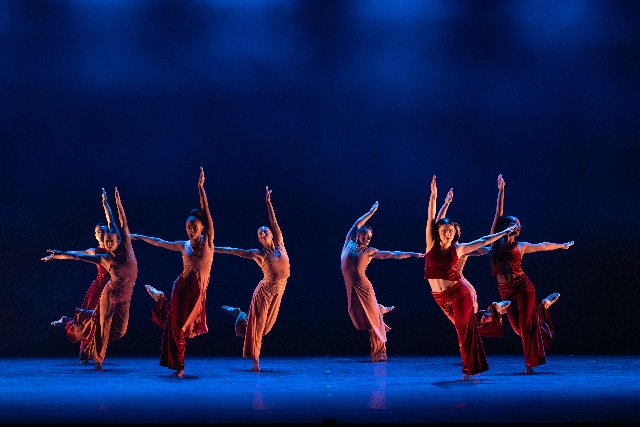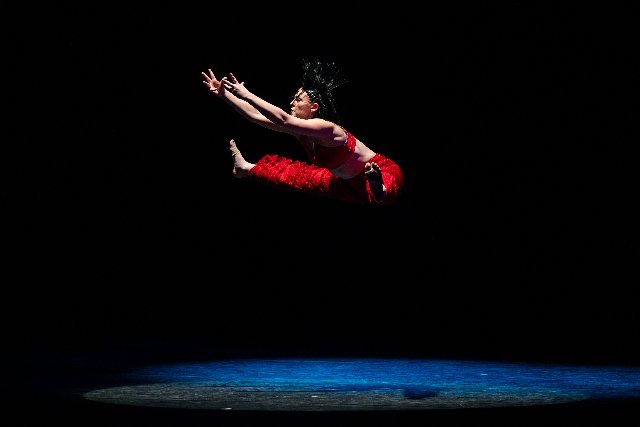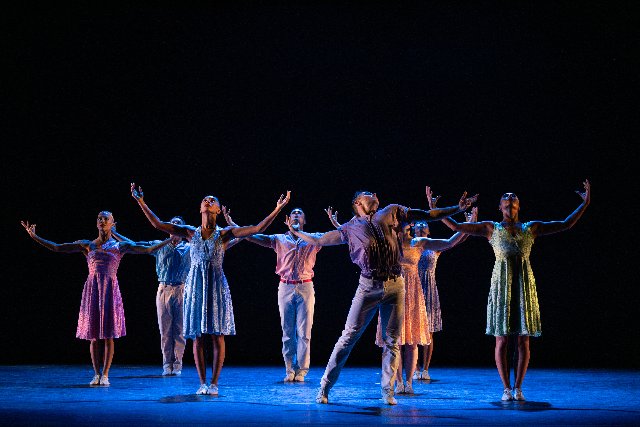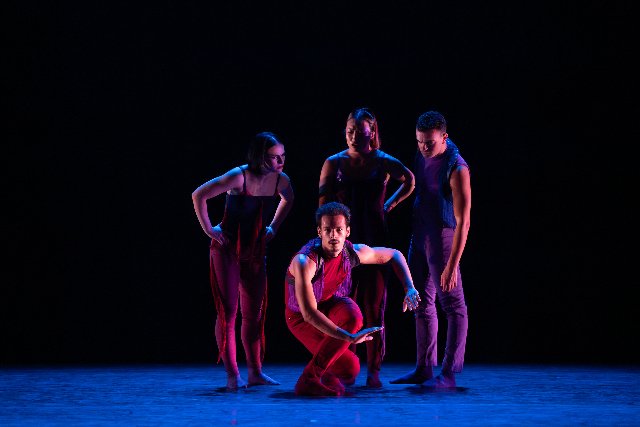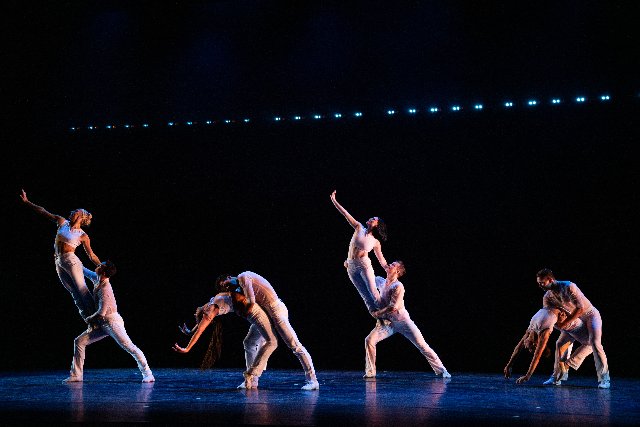Parsons Dance at Jacob’s Pillow
Ended Joyously with September by Earth Wind & Fire
By: Charles Giuliano - Aug 12, 2024
Parsons Dance
Jacobs Pillow
Ted Shawn Theatre
August 7-11, 2024
Artistic Director, David Parsons
Dancers: Zoey Anderson, Megan Garcia, Tea Perez, Luke Romanzi, Joseph Cyranski, Justine Delius, Joanne Hwang, Emerson Earnshaw
Swing Shift (2003)
Choreography David Parsons
Lighting Howell Binkley
Costumes, Mia McSwain
Music, Kenji Bunch
Takademe (1996)
Choreography, Robert Battle
Lighting Howell Binkley
Costume, Missoni (original) Barbara Erin Delo (recreated)
Music Sheila Chandra
Nascimento (1990)
Choreography, David Parsons
Lighting, Howell Binkley
Costumes Santo Loquasta (original) Barbara Erin Delo (recreated)
Music, Milton Nascimento
Excerpt of Finding Center (2015)
Choreography, David Parsons
Lighting, Howell Binkley
Costumes, Naomi Luppescu
Visual art, Rita Blitt
Music, Thomas Newman
Juke (2024)
Choreography, Jamar Roberts
Lighting, Christoper S. Chambers
Costumes, Christine Darch
Music, Miles Davis
Caught (1982)
Choreography, David Parsons
Lighting concept, David Parsons
Lighting, Howell Binkley
Music, Robert Fripp
Shining Star (2024)
Choreography, David Parsons
Lighting, Howell Binkley
Costumes, Mia McSwain
Music, Earth, Wind & Fire
David Parsons first performed at The Pillow as a leading member of Paul Taylor’s company from 1978 through 1987. With renowned lighting designer, Howell Binkley, he launched the Parsons Dance company on the outdoor stage in 1987. He returned to the Ted Shawn Theatre many times through 2002, now, for the first time since then.
An athlete and wrestler native to Kansas City at 17 he left for the Alvin Ailey Company on scholarship. The transition from the strength of an athlete to a leading dancer occurred under the mentor Paul Taylor. The young Parsons keenly observed how Taylor created dance and that informed his transition to choreography. That athleticism is conveyed in the work of his well trained company.
The return to Pillow offered an overview of the company in seven works spanning the 1982 masterpiece Caught to two new works. Parsons choreographed five of the works with one each by Robert Battle and Jamar Roberts. The selections testified to the stylistic and aesthetic range of the company.
The program began with an ensemble work Swing Shift (2003) by Parsons set to music, violin and piano, by Kenji Bunch. It starts with a tall female dancer striking iconic poses. They might have been sculptures of goddesses. The pace of the music was subdued as she is then swathed by and blends in with the company. There is a gasping device as other dancers take lead and then vanish to be replaced by another. This quick switch is accomplished by the masterful lighting of Binkley. As the piece evolved there were many combinations of solo, duet. trio and quartet. The dancers constantly morphed and regrouped with mercurial fluidity.
Nothing prepared the audience for the shocking and original Takademe (1996) by Robert Battle. The piece, one of his first, was created when he was still with Parsons. He took it to Alvin Ailey where he has served as artistic director.
The fast paced, staccato, “Speaking in Tongues, II,” is sung/ executed as an Indian styled rap by Sheila Chandra. Three women alternate and for our performance it was Zoey Anderson, a star of the company, and a Jacob’s Pillow alumna. She was attired in bright red with fringed pants which shimmered. With awe inspiring robotic moves she matched the music note for nuanced note. The work, which could not have been more inventive, was strange yet completely arresting.
Nascimento based on a donated extended work by Milton Nascimento was ambitious but disorienting. The piece, choreographed by Parsons, lacked cohesion. Nascimento, a legendary Brazilian singer/ composer, is much admired in the jazz world particularly for collaboration with Wayne Shorter.
Attired with women in pastel skirts, men in tan pants and short sleeved shirts, we anticipated a form of easy social dancing. That prevailed at first, but morphed into complex patterns and partnering. At one point the group fell to the floor and paused in a cluster. The stage went black and the audience applauded. In a blink they resumed dancing in what seemed like an anti-climax.
Parson’s excerpt of Finding Center, was just that. It proved to be too brief to really get a handle on.
From 1982 Caught is Parson’s most stunning and successful work. Several dancers perform it and I saw Luke Romanzi. It was Parson’s concept but made possible by the invention of Binkley. The dancer appears in a spot which follows her. Then, with bursts of strobe light, she leaps and appears to be suspended in air. With a knowing smile she is back in the spotlight before taking off again. It’s dance as magic.
A new work Juke by Jamar Roberts is ambitious but problematic. It is set to “Spanish Key” from the game changing, fusion, 1970, Miles Davis double album Bitches Brew. He went through multiple personnel changes to find a means of incorporating rock and soul into his ‘brew.’ The core of that was a young, non jazz, electric bass player, Michael Henderson. The bass was to lay down a pulsing ostinato. That was enriched by drummer Jack DeJohnette and the percussionist Aierto. For a time he used both Chick Corea and Keith Jarrett on Fender electric pianos. Keith hated that. Gary Bartz provided soprano sax. Miles liked to get the rhythm section cooking then coast on that with his horn. The band was all about a substructure to support his riffs. This was a world away from the classic ensemble work of Kind of Blue.
One may say that inspired the approach of Roberts with his choreography for this galvanic but challenging music. The dance often seemed inspired by but not bonded to the music. This parallel but not connected approach is a trope of modern dance rooted in Merce Cunningham and John Cage. With that in mind it was a clue to what was experienced. The dancers truly captured the essence and energy of Davis. That said, this was work with an elevated degree of difficulty.
For the finale, with Parsons' new work Shining Star, set to music by Earth Wind & Fire, it was time to sit back and enjoy. In white pants and tops by Mia McSwain there was a workout look. The music is joyously infectious particularly the familiar anthem “September.”
Yes, it was a crowd pleaser, but after the heavy lifting evoked by the cutting-edge company the audience deserved it. How better to end a diverse and challenging program?

